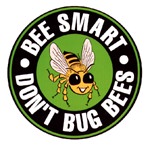
1. I have heard of "killer bees," what are they?
The socalled "killer bees" are actually a strain of honey bee known as the Africanized honey bee. Africanized honey bees look exactly like the common European honey bee. Only highly trained specialists using sophisticated laboratory equipment can tell them apart.
2. Where do they come from?
Africanized honey bees were first introduced into Brazil in 1956 in an attempt to improve honey production in the tropics. They were accidentally released into the wild, and have been moving slowly towards the United States ever since. A few colonies were found in Texas in 1990. They entered Arizona in 1993, along the southern border.
3. How dangerous is a sting by an Africanized honey bee?
If you are stung by one Africanized honey bee, it will be the same as a sting from the com mon European honey bee. The individual stings are not more powerful or painful. In fact, they are slightly less potent than the European honey bee. Even one honey bee sting can be dangerous, however, if you are allergic to them. If you have symptoms other than pain and localized swelling, you should always seek medical attention immediately.
4. Why are they called "killer" bees?
Africanized honey bees have received a great deal of notoriety because they defend their hives (or colonies) so diligently. Many more bees come to the defense of the colony and they are much more likely to sting, even with minimal or no provocation. Victims of attacks by Africanized honey bees may be stung hundreds of times. Away from the hive, however, they are no more aggressive than other bees or wasps. They will not form large swarms and hunt for you.
5. What should I do if I am attacked?
The best strategy is to RUN away as fast as you can. Get to the shelter of a house or car as quickly as possible. Because the bees target your head and eyes, try to cover your head as much as you can, without slowing your progress. Do not flail or attempt to swat the bees, just get away fast. If you are far from shelter, try to run through tall brush. This will confuse and slow them while you make your way out of the area. If you see someone being attacked by bees, encourage them to run away or seek shelter. Do not attempt to rescue them your self, seek emergency help.
6. What should I do after I have reached safety?
When a honey bee stings, it leaves its stinger in the skin. This kills the honey bee, so it can't sting again. Once you are away from the bees, remove all stingers from your body. Do not pull them out with tweezers or your fingers, as this will only squeeze more venom into the wound. Scrape them out sideways using your fingernails, the edge of a credit card, or with a dull knife. If you are feeling ill, or if you have any reason to believe you may be allergic to bee stings, seek medical attention immediately.
7. What if I notice a honey bee swarm near my home?
Each spring, and to a lesser extent during the fall, about half of the work force of a honey bee colony separates from the rest and flies out to form a new colony at a different site. While they are in transition, the bees are called a "swarm." When they are swarming the bees tend to be mildmannered because they do not have a nest to defend, but it is still best to avoid them. Even though they may be resting at a site, they may move on shortly. DO NOT DISTURB HONEY BEE NESTS OR SWARMS. Don't throw rocks, or other objects, or molest with firearms. If the swarm has begun to build a wax honeycomb, they should be removed while the colony is still relatively small.
8. What if I find a bee colony near my home?
Don't panic if you find an established honey bee colony in your neighborhood. Keep every one away. Check the Yellow Pages for pest control operators, beekeepers or other bee removal experts in your area who will remove the colony. Do not try to remove colonies yourself.
9. How do I bee proof my home?
To prevent bees from settling in your house or yard, keep all holes and cavities in trees or outside walls filled or covered. Cover the hole of water meter boxes with a rock and check regularly. Remove any trash or debris that might serve as a shelter for bees, such as over turned clay pots. Solitary, foraging honey bees are often attracted to evaporative coolers as a source of water. Bees can be discouraged by placing a few ounces of pine-scented liquid cleaner in the water. Pet water and bird baths may be attractive as well. Add two (2) table spoons of vinegar per gallon of water to discourage bees. Individual bees gathering pollen and nectar from flowers should be left alone.
It is recommended that you (or a service) inspect your home and property at least once a month for signs of honey bee swarms or colonies.
10. Should all bees be killed?
No, beekeepers should be encouraged to keep up their managed colonies. Honey bees pollinate many vegetables, fruits, and nuts, in addition to supplying us with honey.
